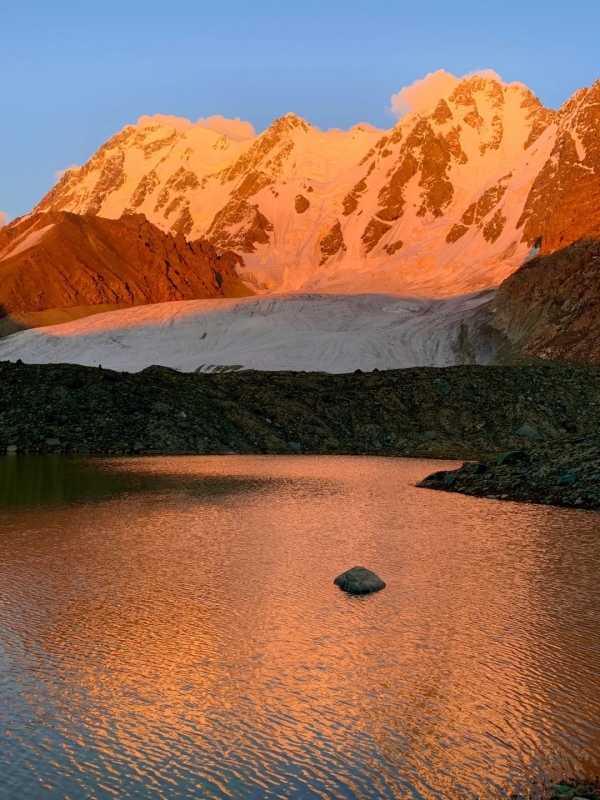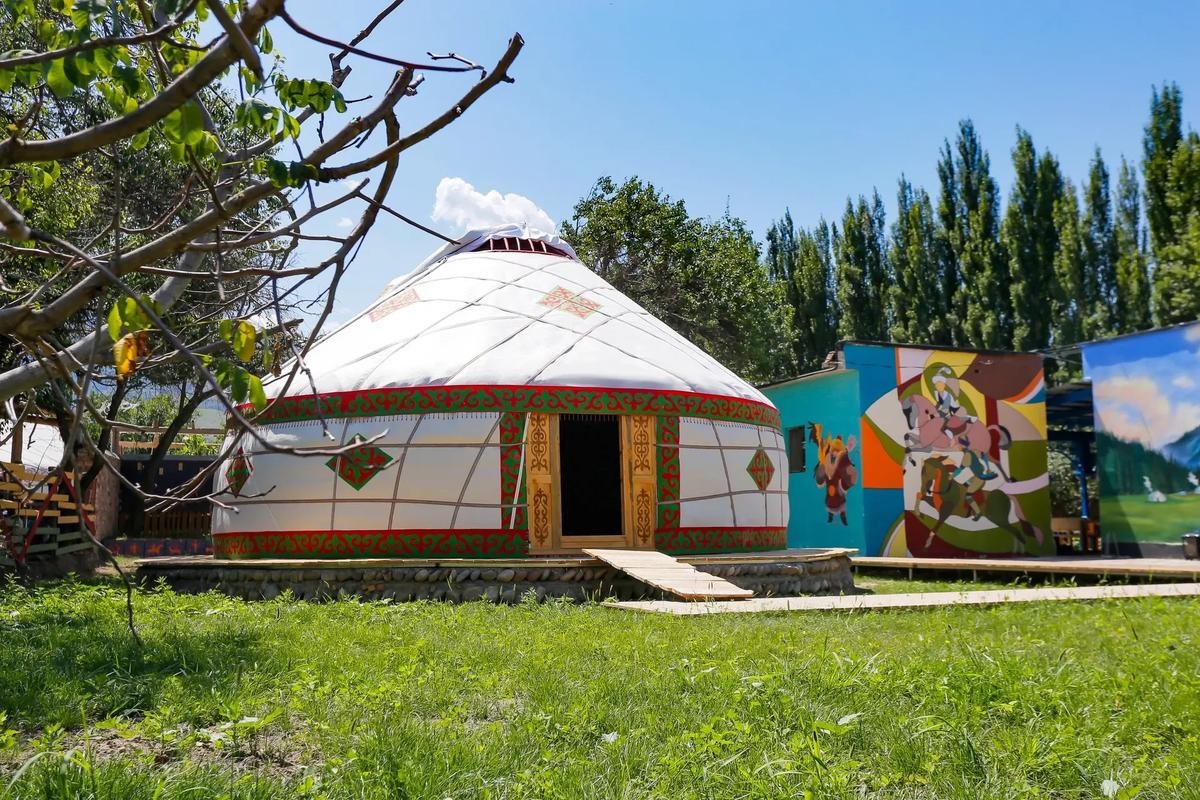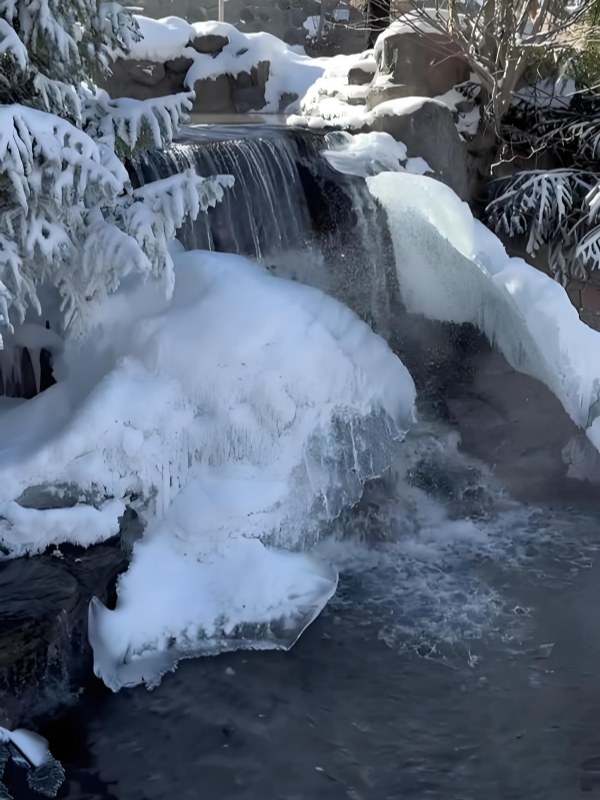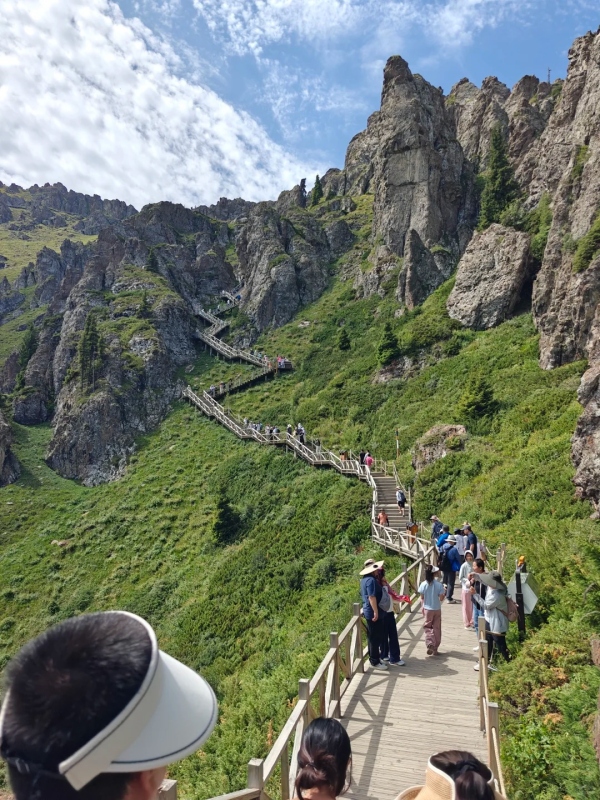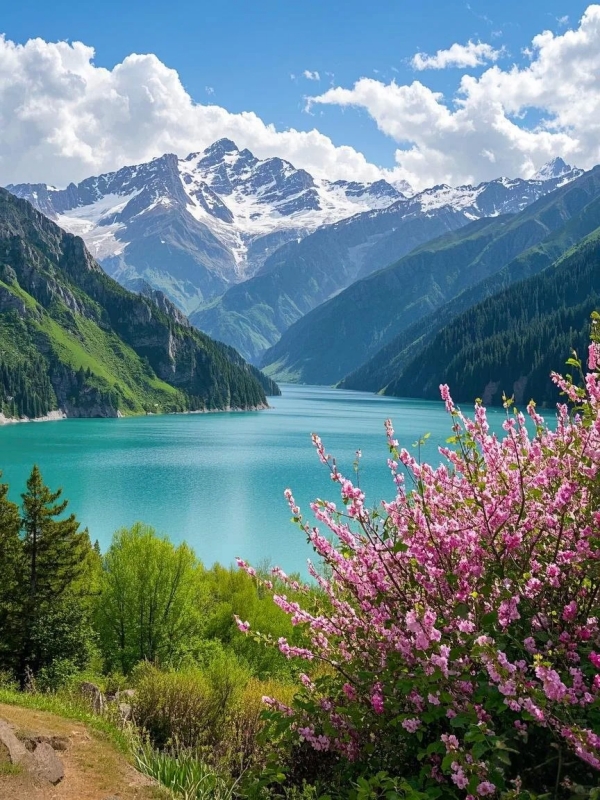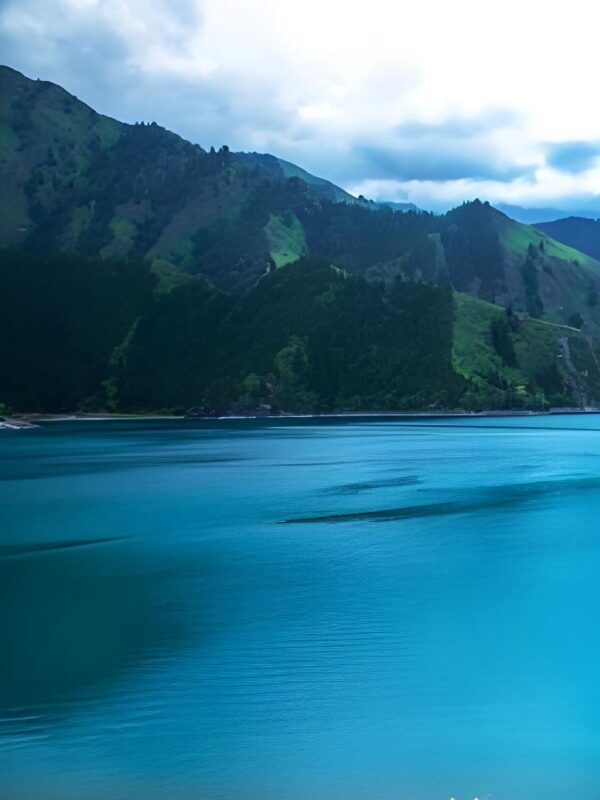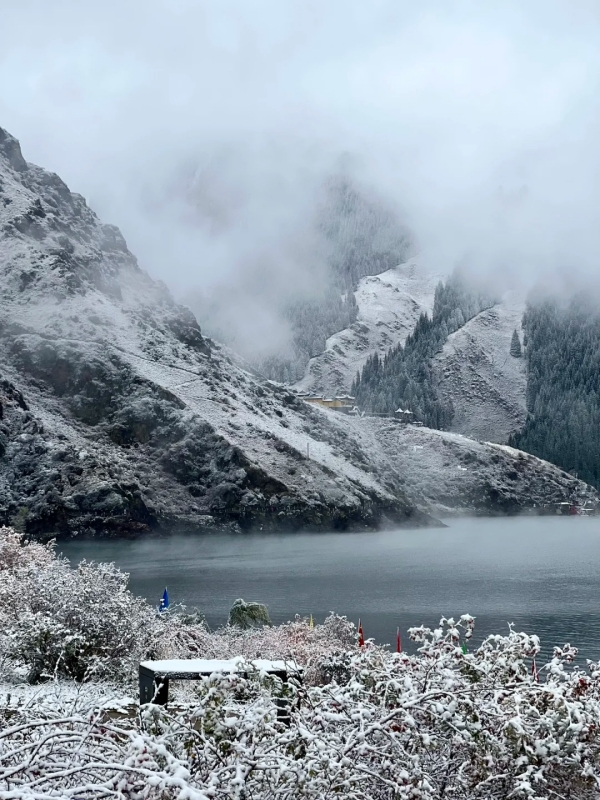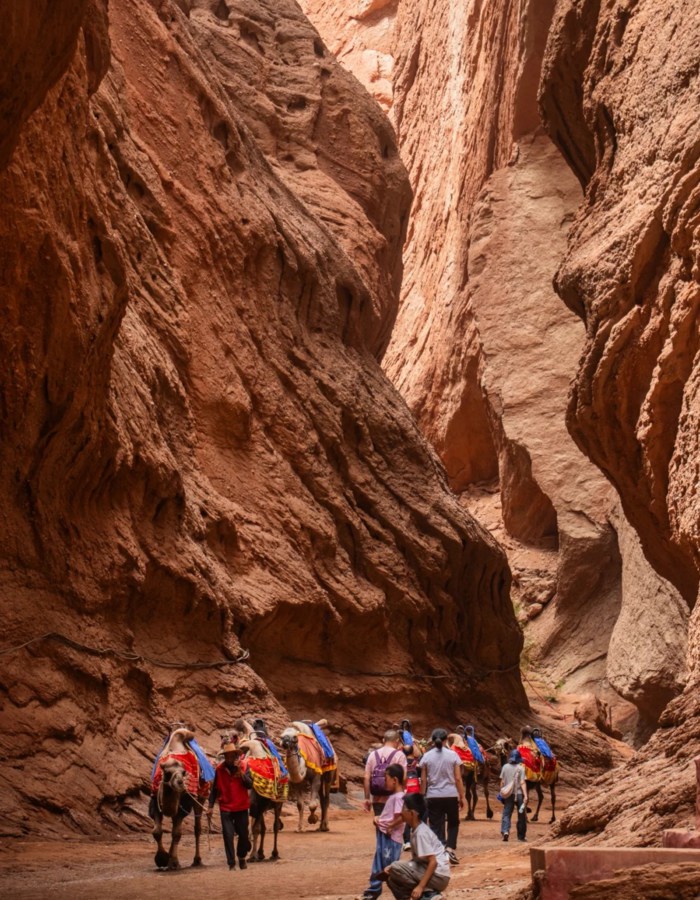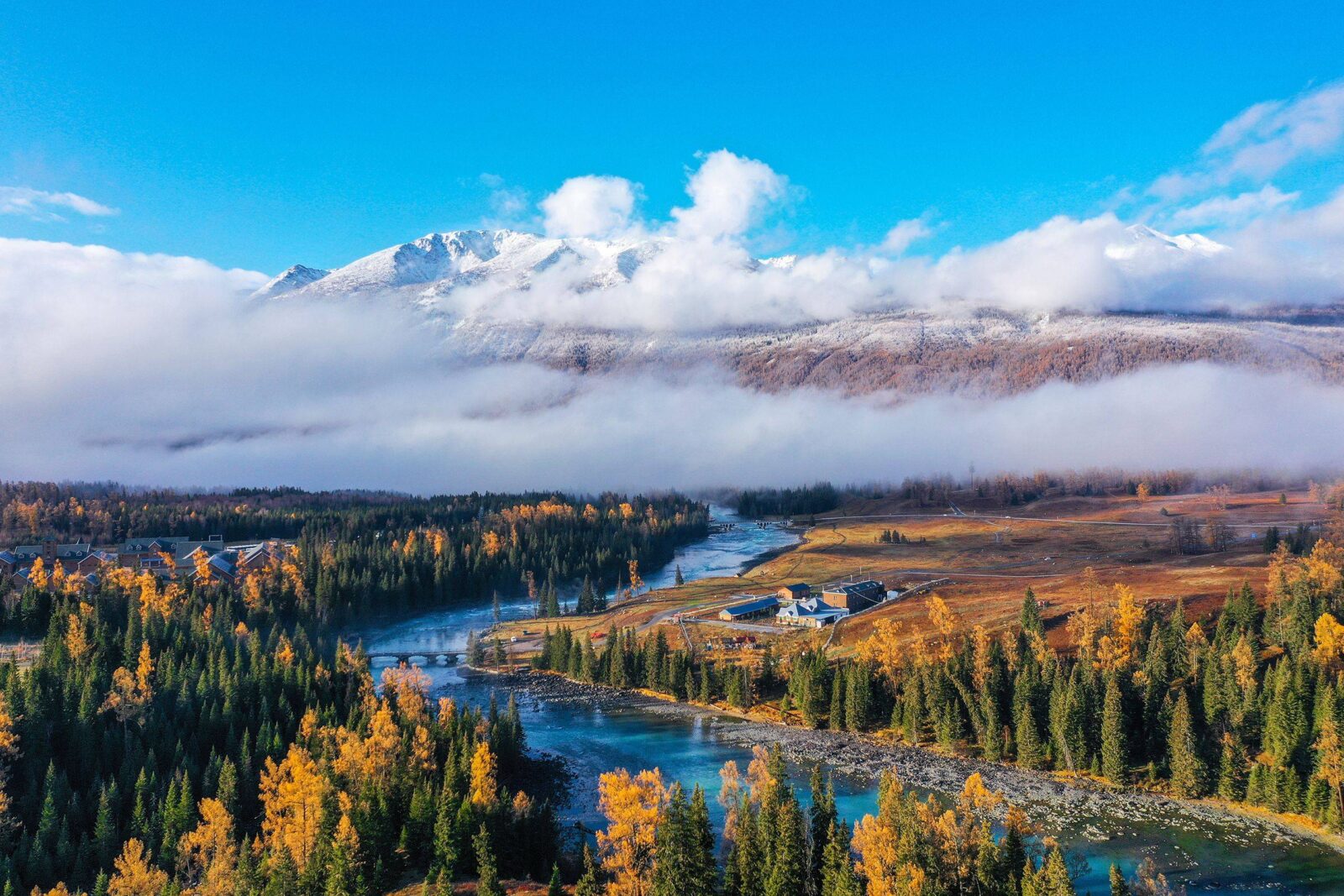
Tianshan Tianchi Lake
Tianchi (Heavenly Lake) is a stunning crescent-shaped alpine lake just a two-hour drive from Urumqi. Its glacial waters are an impossibly vivid blue—so clear they perfectly mirror the surrounding Tianshan Mountains, including the 5,445-meter snow-capped Bogda Peak towering overhead.
It’s more than a postcard-perfect spot. A 2013 UNESCO World Heritage Site and one of the world’s oldest Quaternary glacial moraine lakes, Tianchi sits at 1,910 meters—boasting high-altitude drama without Tibet’s harsh altitude sickness. The 160-square-kilometer scenic area surrounds the 3.4km-long lake, mixing pine forests, meadows, cliffside Taoist temples, and Kazakh yurts (where you can sip creamy milk tea amid grazing sheep).
Whether you’re planning a day trip or an overnight yurt adventure, this guide covers everything you need: transport from Urumqi, real costs (no tour company markups), can’t-miss viewpoints that’ll wow your friends, and tourist traps to skip.
📋 Quick Info: Everything of Tianchi Lake at a Glance
| Category | Details |
|---|---|
| 🏔️ Names | Tianchi Lake (天池 - TiānchÍ) • Heavenly Lake • Tianshan Tianchi |
| 📍 Location | Tianshan Mountains, 110km from Urumqi, Xinjiang • 43.8847°N, 88.1294°E |
| 🎫 Entry & Hours | ¥155 (includes shuttle) • 8am-8pm daily • Students ¥77.50 • Seniors 65+ ¥100 • Winter (Nov-Mar) ¥80 |
| ⛰️ Elevation | Lake: 1,910m • Maya Mountain: 3,056m • Bogda Peak: 5,445m |
| ✨ What Makes It Special | UNESCO World Heritage Site • Ancient moraine lake • Turquoise glacial waters • No altitude sickness risk |
| 🎯 Top Activities | Cable car to Maya Mountain (¥220) • Boat cruises (¥100) • Lakeside hiking • Temple visits • Yurt camping |
| 🏛️ Cultural Significance | Sacred Taoist site since Yuan Dynasty (13th century) • Home to Kazakh herders • Xi Wangmu (Queen Mother of the West) legends |
| ⚠️ Important Rules | NO swimming (protected area + freezing water) • NO camping outside designated areas • NO fires/BBQ • Respect temple etiquette |
Why You'll Fall in Love with Tianchi (And What Makes It Worth the Trip)
The Geology Itself is Awe-Inspiring
I will omit the longer science lecture, but this is important: Tianchi is one of the oldest moraine lakes in the world, showing intact shapes of evolutionary character centuries of age. The beautiful turquoise color? That is from the glacial melt-water flowing away daily from Bogda Peak. The crescent shape? Burrowed out by valley moving through old ice-age glaciers.
Where I got the strongest kick was in seeing Bogda Peak change during the day. Pink at dawn, brilliant white at noon and gold at sundown. The mountain feeds the lake, the lake reflects the mountain, and here is just the best of geological relationships which students of geography travel half around the world to study. If Tianchi felt like heaven’s mirror, wait till you see its twin at Dianchi Lake, Kunming.
The Culture Runs Deep Here
The Yuan Dynasty Taoist monks built temples on hillsides here in the 13th century, and the people worship here today. Kazak families bring their herds up every summer as they have done for centuries, establishing yurts which would sell samples of milk-tea, or tell legends about the bathing of the Chi1n Mother of the West in these waters.
You are actually walking things which merchants of the old Silk Road of centuries ago sat down to rest from their labored trading rides. The lake is not scenery but a holy land. It is not a scenery but alive, with its living layer stories of groups which tourist pamphlets cannot reflect. Tianchi whispers of myth; Qinghai hums with living faith — discover both in Qinghai Lake.
It's Jaw-Droppingly Accessible
This blew my mind: No need for mountaineering ability or expensive gear to reach one of China’s most awesome alpine lakes. Paved roads? Yes. Regular shuttle bus service? Yes. Do the facilities exist to enable gramps and toddlers to visit comfortably? Yes!
Compare that to other famous Chinese lakes. Kanas Lake takes two days travel from Urumqi. Sayram Lake offers wild beauty of nature yet no facilities. Tianchi lake offers favorable features of both. It is beautiful and rugged in natural character, yet it has facilities of English signs, and the boardwalks are up to the wheel-chair-standard, and are 1,910 meters high up where there is beauty and comfort instead of gasp and stress. For first-timers to Xinjiang, Tianchi hits the sweet spot: developed enough for comfort, wild enough for adventure, close enough for a day trip, interesting enough you'll want to stay longer.
Things You’ll Actually Want to Do at Tianchi Lake — What’s Worth Seeing
Ride the Maya Mountain Cable Car — When the Sky’s on Your Side
Cost: ¥220 round-trip • Duration: 3 hours
This cable ride gives you the most epic view of Tianchi Lake. You’ll rise to 3,056 meters, cross pine ridges, and then hike 1.5 km to the summit deck. From there, the turquoise crescent of Tianchi stretches below, with Bogda Peak shimmering across the valley. On a clear day, you can even spot Urumqi’s skyline 110 km away.
Pro tip: June and September are gold. Clouds? Skip it. You’ll thank yourself later. Altitude’s real—pace those last steps and sip plenty of water.
Climb Up to Xiwangmu Temple — Where Myths Still Whisper
Opening Hours: 9:00–17:00
Built in the Yuan Dynasty, this Taoist temple clings to the hillside. Locals say the Queen Mother of the West bathed here with the Eight Immortals. Red pillars, drifting incense, and murals bring the legend alive.
Climb 300 steps to the main hall, then another 200 to Juxian Palace for a killer shot: temple roofs in front, Tianchi Lake and Bogda Peak behind.
Heads up: Don’t ring the bells unless invited—locals see it as disrespectful.
Find the Tiny Tianchi Lakes — Hidden Corners Nobody Talks About
In the northern woods sit two secret gems: East Tiny Tianchi (Feilongtan) with its 20-meter waterfall and turquoise pool, and West Tiny Tianchi (Qianlongyuan), a quieter lake perfect for spotting foxes or squirrels. Few visitors ever find these peaceful pools, and the forest air smells of pine and damp earth. The sound of falling water echoes through the trees, making it feel like you’ve stumbled into a hidden mountain sanctuary.
Safety note: Trails get slippery after rain. Wear solid shoes and check with staff before heading out.
Wander the East Shore Trail — Where the Crowds Disappear
Forget the packed north boardwalk. Head east instead. This 2 km trail drifts through pine forest and shrines, with glimpses of the lake shining between trees. The air smells of pine needles and cool mist rising from the water. Every turn opens to a new angle of the lake, sometimes glowing silver under shifting clouds. It’s Tianchi at its calmest.
Bring: Water, good shoes, and time. It links to Xiwangmu Temple in about 45 minutes of gentle climbing.
Ways to Experience Tianchi Lake — Boat or Boot, Your Choice
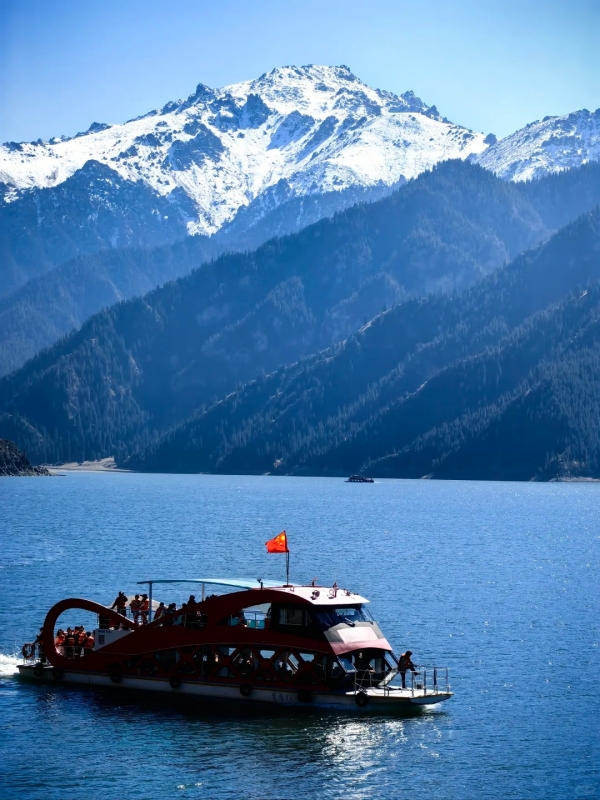
Boat Cruise
Hop on a Boat — Stories, Reflections, and a Bit of Magic
Option 1: Circular Tour (¥100 / 30 min)
Cruise over still waters while guides share Xi Wangmu legends — tales of the Queen Mother of the West hosting celestial banquets where peaches of immortality ripened once every 3,000 years. Bogda Peak’s reflection steals the show, said to be the sacred mirror through which the goddess watched the mortal world. Great for easy photos and chill vibes.
Option 2: Temple Shuttle Boat (¥40–60 / 15 min)
Cuts out a 2 km walk to the temple—great if you’re short on time or energy. The short ride skims across emerald water that glitters under sunlight, and mountain reflections stretch beside your boat. You’ll hear the engine hum echo off the cliffs as wind brings faint temple bells from afar, giving the trip a touch of calm anticipation before you step ashore.
Real talk: The circular tour’s pricey for what you get. Trails give you the same views for free. Morning trips (10–11 a.m.) = mirror water.
Do the Full Lake Circuit — For Those Who Like to Earn Their Views
Distance: 15 km • Duration: 5–6 hours • Difficulty: Moderate to tough
Circle the entire lake—northern side easy, southern side wild. Expect meadows, streams, yaks, and faint trails through grass.
Bring: 2 liters of water, snacks, offline maps. Only try it May–October when snow’s gone.
The payoff: Silence, solitude, and the feeling you’ve stepped into your own National Geographic moment.
Best Time to Visit Tianchi Lake
- Bloom of Tianchi Lake
- Summer of Tianchi Lake
- Winter of Tianchi Lake
Summer Peak Season (June-August): Beautiful But Brutal
| Pros | Cons |
|---|---|
| ☀️ Warmest weather 15-25°C | 😰 Up to 20,000 visitors daily |
| ✅ All facilities operating | 💰 Prices 30-50% higher |
| 🌸 Wildflowers in June-July | ⏰ 30+ min shuttle waits |
| 🚡 Cable car runs daily | 📸 Crowded photo spots |
Summer offers warm temperatures and full access to all facilities. Wildflowers bloom across alpine meadows, but are at their best in June and early July. From July to August, tourist crowds increase because of holidays for Chinese schools. Shuttle buses are quickly filled, the boardwalk becomes a crawling mass of humanity and hotel prices rise abruptly. If you wish to avoid summer crowds: Visit during weekdays and not weekends. Arrive before 0900 (terrific numbers of tourist buses unload between 10:30 and two in the afternoon). Stay overnight, to enjoy the empty hiking trails after six in the evening, when the day tourists have departed.
Shoulder Seasons (May & September): The Sweet Spot
This is my pick. Temperatures at 10-20°C require a light jacket but stay pleasant midday. Crowds drop 50% compared to peak summer while accommodation costs 20-30% less. May brings fresh green growth and full waterfalls from snowmelt. September showcases golden aspen trees creating stunning contrasts with turquoise water—I walked 20 minutes without seeing another person on the east trail, impossible in July.
The trade-off? Weather becomes less predictable with higher rain chances. September sees occasional early snow at higher elevations, though the lake area rarely gets snow before October. Check forecasts obsessively before committing to that ¥220 cable car.
Autumn & Winter: Extremes for Adventurers
October delivers peak foliage early-to-mid month—golden trees, blue water, white peaks creating photographer's dream conditions. But infrastructure starts shutting down, with restaurants closing and cable cars running less frequently on windy days. By late October, Kazakh families pack up yurts. Heavy snow can arrive suddenly, so check conditions carefully.
Winter (November-March) transforms the landscape with brutal cold at -15°C or lower. The lake freezes solid into eerie silence. Entrance drops to ¥80 but cable cars and boats don't operate. You'll see maybe 100 people daily versus summer's 20,000. Some winters host Ice & Snow Festival with sculptures and winter sports demos. This suits hardy travelers who pack serious cold-weather gear and prioritize unique experiences over comfort.
Getting There: Your Transport Options from Urumqi
Quick Comparison Table
| Method | Cost | Time | Best For | Flexibility |
|---|---|---|---|---|
| 🚌 Public Bus | ¥15-25 | 1.5-2 hours | Solo budget travelers | Low (fixed schedule) |
| 🚐 Organized Tour | ¥150-300 | Full day | First-timers, no planning stress | Low (group schedule) |
| 🚗 Private Car/Taxi | ¥200-400 | 1.5 hours | Groups of 3-4 splitting costs | High (your schedule) |
🚌 Public Bus: Budget Champion
Departure Point: Urumqi's Beijiao Bus Station
Schedule: 9:30am and 10:30am departures • 5:30pm return
Cost: ¥15-25 one-way
The ride takes 1.5-2 hours, reaching Fukang City first then continuing to the scenic area entrance. Some buses require transfers at Fukang to smaller minibuses.
Pro: Saves serious money if you're solo
Con: You're stuck waiting for that 5:30pm return even if weather turns bad or you finish early—miss sunset opportunities
Travel tip: Arrive early since buses leave when full. Bring snacks and water—stations have limited food. The entrance ticket (¥155) is purchased separately at the gate.
🚐 Organized Tour: Zero Planning Required
Cost: ¥150-300 per person
Includes: Hotel pickup (8-9am), round-trip transport, sometimes lunch
Return: Around 6pm
Zero planning required—just show up at your hotel lobby. However, tours lock you into fixed schedules, arriving between 10:30am-2pm when crowds peak. You get limited free time since the group moves together. Some tours stop at souvenir shops where guides earn commission.
Smart move: Book through your hotel rather than strangers at People's Park entrance where fake guides operate. Read recent Ctrip or Trip.com reviews first. Small group tours cost more but offer better flexibility than 40+ person buses.
Best for: Solo travelers or those who prefer structured travel over independent exploration.
🚗 Private Car/Taxi: Maximum Freedom
Cost: ¥200-400 for full day (split among 3-4 people = ¥50-100 each)
Journey: 1.5 hours via G216 highway
You control timing completely—leave at 7am for sunrise or stay late for sunset photography. The driver waits while you explore.
Before departing: Agree on waiting time fees upfront (¥50/hour is standard). Confirm the total includes highway tolls and parking. Many Urumqi hotels arrange cars with drivers who know the route.
Bonus: You can stop at viewpoints along the way or detour to Dabancheng Wind Farm. Write down pickup times and locations in Chinese if you don't speak Mandarin.
Watch out: Some drivers suggest commission-earning restaurants or activities—you're free to decline.
Inside the Scenic Area: The Mandatory Shuttle System
Everyone rides eco-buses included in your ¥155 entrance ticket. These depart every 10 minutes from 8am-8pm. The 30-minute ride winds through pine forests on mountain roads.
Motion sickness warning: Take medicine if you're prone—lots of switchbacks. Sit on the right side for waterfall views. The left faces the mountain wall.
Buses stop halfway at a "Kazakh Cultural Village" that tour guides push. You can skip this commercial trap and stay on the bus. They drop you at parking 800 meters from the main lake area.
Skip the ¥10 electric carts—walk this flat 10-minute path with nice valley views. During peak summer, expect 20-30 minute waits for return buses. Don't miss that 8pm last bus.
Ticket Prices, Costs & Planning
Entrance Fees Breakdown
| Item | Price | Notes |
|---|---|---|
| 🎫 Base Entrance + Shuttle | ¥155 | Required for everyone |
| 👶 Children Under 1.2m | Free | Height-based, not age |
| 🎓 Students with Valid ID | ¥77.50 | 50% discount |
| 👴 Seniors Over 65 | ¥100 | Varies by season |
| 🚡 Maya Mountain Cable Car | ¥220 | Optional, weather-dependent |
| 🚢 Circular Boat Tour | ¥100 | Optional, 30 minutes |
| 🛶 Temple Shuttle Boat | ¥40-60 | One-way or round-trip |
| 🛒 Electric Cart | ¥10 | Skip it—walk is easy |
Your base entrance ticket at ¥155 includes shuttle buses and covers the main lake area, all trails, and Xiwangmu Temple. The popular add-ons cost extra. Do everything and you're spending ¥485 per person before food or souvenirs. Most typical visitors invest ¥250-350 total for 4-5 hours. Winter discount (November-March) drops entrance to ¥80, but cable cars and boats close. You trade savings for fewer activities. Groups of 10+ qualify for 10% discount—ask other tourists in the ticket line if they want to combine for the group rate.
Sample Itineraries with Time Budgets
Half-Day Visit (4 hours): Arrive 9am, shuttle up, walk north shore boardwalk, choose either boat cruise OR east trail (not both), return by 1pm. Back in Urumqi by 3pm. Good for tight schedules or combining Tianchi with other Urumqi activities.
Full-Day Visit (8 hours): Leave Urumqi 7:30am to reach entrance at opening. Take first shuttle up, hit east trail before crowds, visit temple and climb to Juxian Palace (2-3 hours). Lunch break—bring your own food or pay ¥50-80 at lakeside restaurants. Afternoon cable car if weather's clear (3 hours including waiting). Finish by 5pm before last bus at 8pm.
Overnight Stay: Kazakh yurts cost ¥50-100 per person with dinner. You sleep on mattresses in communal space—bring warm clothes since temperatures drop after dark. Trade comfort for unique cultural experience. The lake empties after 6pm when day-trippers leave. Morning light at 6am hits Bogda Peak beautifully. You'll have boardwalks to yourself until tour buses arrive around 9am.
Food Strategy: Eat Smart or Bring Your Own
At the lake:
- Restaurants near visitor center: ¥40-80 per person (acceptable quality, not exceptional)
- Small vendors: Instant noodles, tea eggs, packaged snacks at marked-up prices
- Water costs ¥5-8 versus ¥2 in the city
Kazakh yurts:
- Traditional meals: Lamb kebabs, naan bread, milk tea for ¥50-100
- Portions are generous with authentic flavors
- No posted menus—confirm costs before ordering to avoid surprises
Budget hack: Pack lunch from Urumqi supermarkets. Saves ¥50+ per person and lets you picnic in scenic trail spots. No fires or barbecues allowed in this protected reserve.
Insider Secrets: What Savvy Travelers Know
Money-Saving Strategies That Actually Work
💰 Skip organized tours and take public bus—saves ¥100+ per person. Pack lunch from Urumqi supermarkets—saves ¥50-80. That ¥10 electric cart is pointless—walk the 800 meters. Visit November-March when entrance drops 50% to ¥80 if you can handle cold and limited activities. Ask strangers at ticket window to form groups of 10 for the 10% discount. Don't waste ¥220 on cable car if clouds block views—check weather forecasts obsessively.
According to TripAdvisor reviews, the ¥100 boat tour feels overpriced for 30 minutes. Shore trails show the same water for free. Tourist trap souvenirs at Tianchi sell for 2-3x Urumqi prices—identical items at Grand Bazaar cost 50% less. Save souvenir budget for the city.
What to Pack by Season
| Season | Must Bring | Nice to Have |
|---|---|---|
| ☀️ Summer | SPF 50+ sunscreen, hat, water bottle, rain jacket | Sunglasses, hiking poles |
| 🍂 May/Sep | Layers (fleece + shell), gloves, warm hat | Thermos for hot drinks |
| ❄️ Winter | Down jacket, thermal underwear, insulated boots, hand warmers | Balaclava, crampons |
UV radiation intensifies at 1,910 meters—sun protection is crucial. Temperature swings 15 degrees between morning and afternoon even in summer. Bring layers even if morning feels warm—evening temps drop 10°C+ after sunset.
Common Mistakes That'll Ruin Your Day
Wearing heels or dress shoes → I've watched tourists slip and struggle. Bring proper footwear with tread—terrain has roots, rocks, mud.
Underestimating the cold → Even summer evenings drop 10°C+ after sunset. Bring that extra layer.
Buying overpriced souvenirs → Wait for Urumqi's Grand Bazaar. Same items, half the price.
Trying to cram everything into 3 hours → Cable car alone eats 3 hours. Temple hike takes 2 hours. Boat adds 1 hour. Pick 2-3 activities you actually care about based on weather and interests, then enjoy those fully.
Ignoring hydration → While 1,910m rarely causes serious altitude issues, staying hydrated prevents headaches.
Best Photo Spots of Tianchi Lake(With GPS Coordinates)
📍 Main Pier (43.8847°N, 88.1294°E)
Classic postcard shots. Shoot 8-10am for best light before harsh midday sun. Use polarizing filter to deepen water and sky blues.
📍 Maya Mountain Summit (43.8792°N, 88.1156°E)
360° panoramas on clear days. Late afternoon light 4-6pm paints peaks golden. Wide-angle 16-24mm lens captures the scale.
📍 Xiwangmu Temple Upper Platform
Layered composition—red temple roofs foreground, blue lake middle ground, white peak background. Midday works since temple faces north avoiding harsh shadows.
📍 East Tiny Tianchi Waterfall
Best July-August when water flow peaks. Shoot downward from viewing platform to capture 20-meter drop and turquoise pool.
Frequently Asked Questions
Q: Can I swim in Tianchi Lake?
Nope. Swimming's prohibited since UNESCO protects this as World Heritage property. Even if it weren't banned, water stays 5-10°C year-round from glacial melt—you'd get hypothermia in minutes. Rangers patrol shores and will stop you. Locals tell "lake monster" legends partly to discourage swimming, partly because the ecosystem has rare cold-water fish. Save swimming for your Urumqi hotel pool.
Q: Will altitude sickness of Tianchi Lake mess me up?
Probably not at 1,910 meters. Most healthy people don't feel effects below 2,400 meters. If you take Maya Mountain cable car to 3,056m, you might get mild breathlessness from rapid ascent. Drink lots of water throughout your visit, avoid alcohol the night before, and take your time. Kids, elderly, and pregnant women generally handle this elevation fine.
Q: What's overnight yurt camping really like in Tianchi Lake?
Authentic but basic. You'll sleep on mattresses with 8-12 other people on felt-covered floor—zero privacy. No electricity, no private bathrooms. Temperatures drop hard after sunset even in summer. Families speak mainly Mandarin and Kazakh with limited English. The payoff? Sunrise over the lake and empty trails before day-trippers arrive at 9am. This works for adventurous travelers prioritizing cultural immersion over comfort.
Q: How does Xinjiang's Tianchi Lake differ from Changbaishan's Tianchi Lake?
Completely different places sharing the name "Tianchi." Xinjiang's version formed from glacial activity at 1,910m with easy access 110km from Urumqi, connecting to Taoist temples and Kazakh culture. Changbaishan's fills a volcanic crater at 2,189m on North Korea border with steep walls, requiring travel to remote Jilin Province. For most international tourists, Xinjiang's Tianchi fits better into China itineraries.
Q: Is phone signal in Tianchi Lake?
China Mobile and China Unicom give 3G/4G coverage around main lake area. Once you hit distant trails or Tiny Tianchi, signal disappears. WiFi only exists at visitor center and some upscale restaurants. No ATMs inside—nearest is at entrance gate. Bring enough cash from Urumqi since many vendors and yurt families don't accept WeChat Pay or Alipay.
Q: What wildlife might I see in Tianchi Lake?
Tourism keeps most animals away from busy areas. Quieter trails offer Himalayan marmots on rocky slopes, red squirrels in pine forests, and birds like golden eagles circling on thermals. Roe deer hide in forests though rarely near crowds. Kazakh herders bring sheep, goats, horses, and yaks to meadows during summer. In the lake, you'll see Schizothorax fish that boat operators let you feed. Early morning or late evening offers better chances.
Q: Can elderly or young children visit Tianchi Lake?
Yes, if sticking to developed areas. North shore boardwalk is paved, flat, and wheelchair-accessible. Shuttle buses require no walking. Kids enjoy feeding fish and seeing yurts. However, Maya Mountain cable car involves stairs plus 1.5km uphill walk at 3,000m. Xiwangmu Temple requires 300+ stone steps. Essential lake views work for all ages—skip challenging activities without missing core beauty.
Q: Where can I charge my phone in Tianchi Lake?
Nowhere really—bring fully charged phone and 10,000mAh+ power bank. Main visitor center has charging stations while waiting for buses. A few upscale restaurants let customers charge devices. Yurts lack electricity. Cold drains batteries faster, so keep devices in inside jacket pockets near body warmth. Use airplane mode to conserve power.
Q: Can I visit Tianchi Lake independently without tours?
Absolutely—saves money and gains flexibility. Take public bus (¥15-25) or hire private car if you've got 3-4 people. Arrive before 9am, buy entrance ticket, board shuttle immediately. Walk the 800m to lake instead of paying for electric carts. Hit east shore trail first when quietest. Download offline maps before leaving Urumqi. Trails have English signs at major junctions.
Q: Is the Tianchi Lake Monster real?
The story started in 2007 when a TV reporter claimed filming six seal-like creatures. Scientists are skeptical—lake's too cold with limited food to support large predators. Probably misidentified logs or tourist marketing. Don't confuse this with Changbaishan's separate legend. Fun folklore to discuss over butter tea, but don't expect seeing anything beyond fish that boat operators let you feed.

